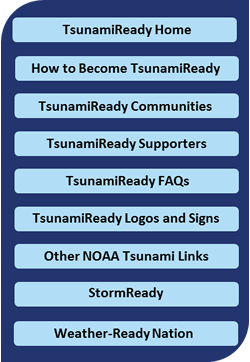NWS TsunamiReady® ProgramWorking Toward a Weather-Ready Nation
|
 |
||
|
In the United States, the threat posed by tsunamis is greatest along the Pacific and Caribbean Coasts, but tsunamis are also possible on the Atlantic and Gulf Coasts. In 2001, recognizing these threats and the vital role played by coastal communities in protecting the nation from tsunamis, the National Weather Service (NWS) and the National Tsunami Hazard Mitigation Program (NTHMP–a partnership led by NOAA that today includes the Federal Emergency Management Agency, the U.S. Geological Survey and 28 U.S. states and territories) established the TsunamiReady program to encourage and recognize community tsunami preparedness. Modeled on the NWS's successful StormReady® program, TsunamiReady helps communities* minimize the risk posed by tsunamis through better risk assessment, planning, education and warning communications. TsunamiReady is a voluntary community recognition program that promotes tsunami hazard preparedness as an active collaboration among federal, state/territorial and local emergency management agencies, community leaders and the public. The main goal of the program is to improve public safety before, during and after tsunami emergencies. It aims to do this by establishing guidelines for a standard level of capability to mitigate, prepare for and respond to tsunamis and working with communities to help them meet the guidelines and ultimately become recognized as TsunamiReady by the NWS. Although tsunamis cannot be prevented, becoming TsunamiReady can help communities minimize their losses. Other incentives to becoming TsunamiReady include:
To learn more about what is involved in becoming TsunamiReady, visit How to Become TsunamiReady or contact your local NWS Weather Forecast Office. *For the purposes of the TsunamiReady program, "community" is defined as a local government entity, an Indian tribal government or a facility that has the authority and ability to implement the TsunamiReady Guidelines. |